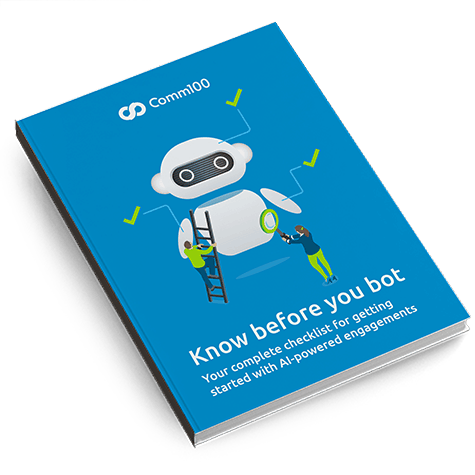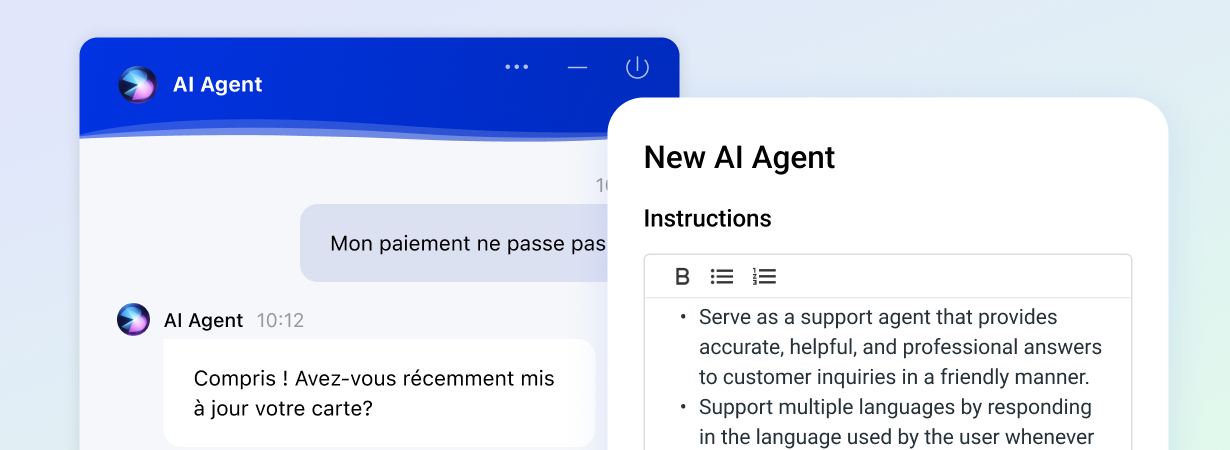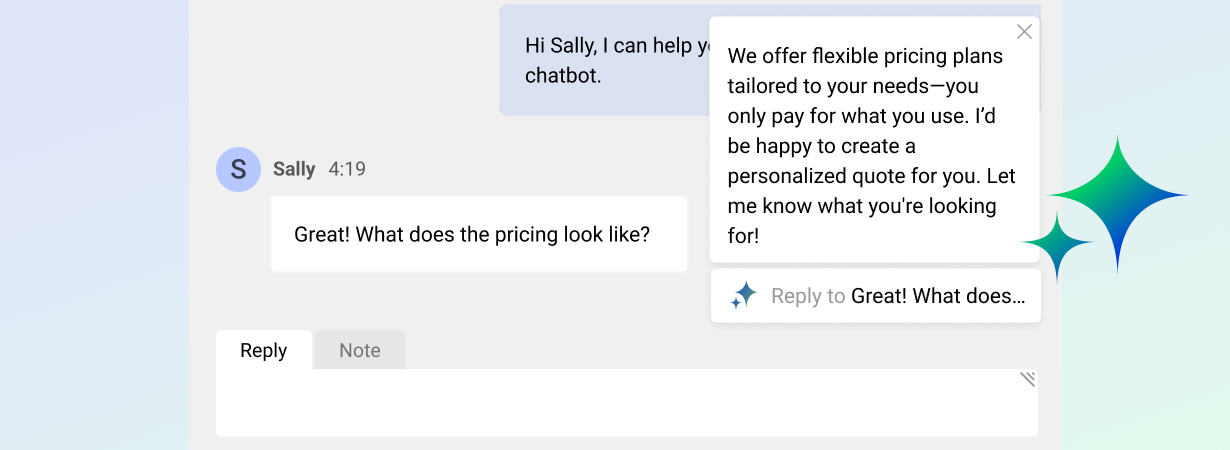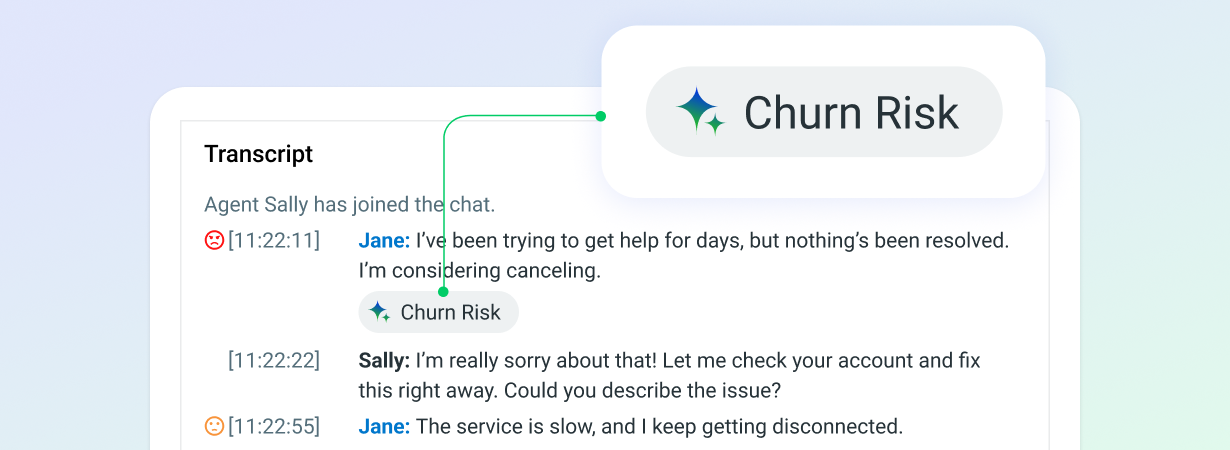Cutting wait time, reducing operational costs, and improving conversions are just some of the chatbot superpowers that companies are benefitting from.
If you’re here because you’re trying to figure out what chatbot software is capable of and how it can help your company grow, you’ve come to the right place.
We have hand-picked some of the best chatbot examples to show you how you could use AI chatbots across channels. You will explore 5 examples of chatbots across industries, plus a case study of how a chatbot resolved 91% of live chat inquiries. Let’s explore the top 6 chatbot examples to inspire you on your automation journey.
1. Chatbots helping mortgage applications
Industry: Banking and finance.
A chatbot is the ideal companion to a home buyer’s journey with a bank. Embedded with resources the bank already has set up within the knowledge base, the chatbot can answer frequently asked questions, say, about the minimum requirements for getting a mortgage, or the bank’s available mortgage plans.
The bot can even provide personalized service to the bank’s clients. It can check their current financial situation and compare it to a mortgage’s requirements. It can then recommend steps to get the customers closer to eligibility. The bot can share links, images and videos to deepen clients’ financial understanding of their home buying journey.
The chatbot can then suggest available appointments with a human bank representative, book the time slot customers prefer, add it to the rep’s calendar, and set the system to send a reminder text to the customers when the appointment approaches.
For more examples of chatbots in banking, take a look at the Top 15 Ways for Banks to Use Chatbots.
2. Chatbots saving lives
Industry: Healthcare.
One of the best chatbot examples is from the healthcare industry. Like in any other industry, AI bots can provide a logistical service, such as helping a patient book a doctor’s appointment or checking whether a certain clinic works with that patient’s health insurance plan. But sometimes, when patients feel too embarrassed or ashamed to talk to a real doctor, they might be completely comfortable asking a chatbot for medical guidance.
One might wonder what a chatbot’s medical expertise is, and whether it’s safe for a chatbot to provide medical advice. The recommendation here is to allow the chatbot to detect potential risks, then scale them to a human physician – or, at the very least, inform the patients the situation is potentially severe enough, that they need to seek immediate medical care.
In this case, the customer service chatbot can show empathy and assure patients the doctor will never judge them. Alternatively, when it comes to sensitive issues, the chatbot can suggest a list of the most loved and trusted doctors in the patient’s area.
There are so many ways that healthcare organizations can use chatbots to automate customer support for clients and patients. Take a look at this slideshare for more chatbot examples – Top 15 Use Cases for Chatbots in Healthcare.
3. Chatbots for a B2B holistic customer lifecycle
Industry: B2B
Chatbots are often associated with B2C verticals, so what is a chatbot’s role in B2B? Here too, it’s multifaceted.
A customer support chatbot is a great way to amplify account-based marketing campaigns. For example, the chatbot can identify when people from key accounts visit your website, and proactively invite them to engage. It can answer their questions, send them content that’s perfect for them, or suggest the next step to take toward a purchase decision.
But whether you engage in ABM or not, you can use the chatbot on your landing pages in a similar way. Instead of letting prospects bounce off a landing page before asking that one important question on their mind, your chatbot can step in and provide instant answers, book an appointment with your sales team, or help customers make a payment right there and then.
Post-sale, your chatbot can be a 24/7 customer success manager. It can help answer questions to simplify the onboarding process, get acquainted with your platform – and offer upsells and cross-sells when a customer is most likely to convert.
4. Chatbots that perfect the human-AI balance
Industry: Education.
The beauty of chatbot software is how it can work together with human agents to help both customer and agent. A university’s contact center, for example, consistently gets questions about a wide range of topics. It serves current students, potential students, past students and faculty from a wide range of programs. Agents can’t possibly remember the answers to all possible questions.
Instead, when a visitor asks a question on live chat, AI automatically surfaces answers from pre-written canned messages and knowledge base articles and presents them to the agent. The agent can then choose the best answer and send it to the customer with a click of a button.
Recommended reading: Why Agents Need Chatbots – and Chatbots Need Agents
It’s one of the best chatbot examples we’ve seen because a university doesn’t need to have a perfect database of answers in order to get started. When agents see a repetitive question – for example, students asking about learning options in a COVID-19 academic year – they can add it to the university’s knowledge base. There, an admin can write an answer, or link to an already existing resource. Next time an agent gets this question, the answer will be surfaced automatically for them.
Industry: Ecommerce.
Many examples of good chatbots can be seen in the eCommerce space where they are being used to drive sales and reduce shopping cart abandonment
Most eCommerce customers know what a chatbot is and feel comfortable using one. That’s why many of them will ask for a chatbot’s help in finding a product they need, figuring out the right size, or even getting styling advice.
Customers also feel comfortable engaging with a customer service bot when the bot itself initiates a conversation. Chatbots can start a chat when they detect a customer stumbling through the site or showing potential signs of cart abandonment. After all, they’re known for reducing shopping cart abandonment rates by up to 20%. But they can also do that when they see a customer is eligible for a promotional offer based on where they are on the site or what they have in their cart. They can reach out and offer an upsell or a cross-sell.
Then, to ensure customer satisfaction remains high after the purchase is complete, chatbots can answer the repetitive customer service questions, and escalate those they can’t to the most appropriate human agent.
Case Study: Tangerine’s chatbot resolves 91% of live chat inquiries
Industry: Telecommunications.
In 2015, Australia-based mobile carrier Tangerine added a B2C offering to its B2B products. Their target market shot up, literally overnight. In March 2019, the Tangerine team received 500 live chat requests. By May 2019, that number had grown to 2,227 chat requests. And in December 2019? Over 6,400. Wait times skyrocketed as a result and it was becoming too much to manage with the number of agents they had at hand.
The company realized it was time to automate its live chat operations and Comm100 was chosen to help them do that. Comm100’s AI Chatbot was implemented and soon after,as much as 91% of the chats that got directly routed to the bot were resolved without a human agent. On top of this, 97% of responses were classified as “high confidence answers,” meaning the bot was accurate in handling issues.
Fast and accurate resolution are two of the best chatbot benefits, but so is shorter wait times. Tangerine’s bot reduced wait time from 78 to 54 seconds, and provided 24/7 support, serving 12% more customers than would have been possible during office hours alone.
You can read the full story here – Comm100 Chatbot Resolves 91% of Assigned Live Chats for Tangerine
What can a chatbot do for your customers?
In most organizations, a variety of leadership roles is set to benefit from incorporating chatbot solutions into the company’s operations. Gather your heads of contact center, support, sales, marketing and finance together, and go over this list. Show them some of these top customer service bot examples and demonstrate what they could do for you.
Start brainstorming what’s possible for your specific situation. Whether you want to build a website chatbot, an in-app chatbot, or a cross-channel chatbot, start with your customers in mind. Also consider what your customers’ most pressing needs are, and where you can find opportunities to improve the experience they have with your brand in day-to-day interactions. Once you know that, it will be easier to decide what a chatbot’s responsibility is in your company.
Start small, test things out, and add functionality as you go. It won’t be long before you see emotional connections with customers growing stronger, leading to higher lifetime value, customer satisfaction, and even advocacy.
If you have decided that your customer engagements could benefit from the artificial intelligence and automation of chatbots, then we recommend that you read this guide:
Know Before You Bot
Straight answers to the 10 most important questions about getting started with chatbots.
Read on
Comm100 eBook







